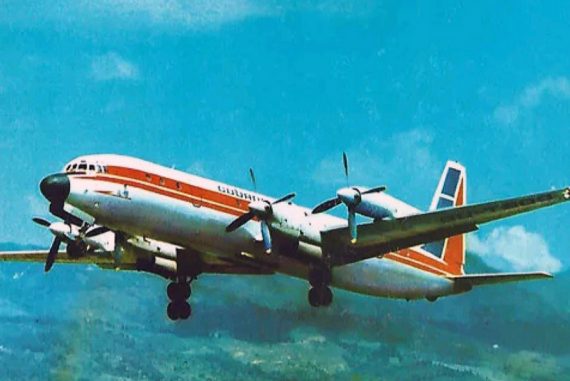Hijacking of a Cubana IL-18

The Cubana de Aviación IL-18 aircraft, with dozens of passengers on board, departed Santiago de Cuba for Havana, on March 27, 1966. It was piloted by Captain Fernando Álvarez Pérez who, just days before, in a conversation among fellow pilots discussing attempted hijackings by individuals seeking refuge in the United States under American laws that hailed them as heroes, expressed with great conviction, “To take the airplane from me, they would have to kill me. Any airplane that departs with me, returns with me!”
While flying over Varadero, at an altitude of 18,000 feet, the tragedy began unfolding. The co-pilot of that flight was Evans Rosales, and the security guard was Edor Reyes. The flight engineer was José María Betancourt, all of whom were in the enclosed space of the aircraft’s cockpit. Betancourt, who had previously been an aircraft mechanic in the Cuban Army Air Force -FAEC- during the time of Batista, but continued working for the Revolutionary Air Force under Castro’s regime, attended flight engineer school and began working at Cubana de Aviación. Suddenly, he pulled out a hidden club and struck the security guard on the head, causing him to fall from his seat. He took the guard’s weapon and shot him three times in the back, killing him. He then turned to the co-pilot, who was seated to the right of the controls, and shot him in the back as well. The co-pilot managed to survive, although the killer believed he was dead. Betancourt then ordered Captain Álvarez, to change course towards Miami.
A dramatic duel at 18,000 feet ensued between the pilot and the flight engineer, who had clearly become a cold-blooded killing machine. Fernando realized how difficult it would be to deceive Betancourt, so he headed towards Florida. However, he used a secret code known only to the pilots, which directly communicated with the Revolutionary Air Force headquarters. They instructed him on what to do. He flew over Key West, which Betancourt cheerfully recognized, and relaxed his vigilance over Fernando. At that moment, Fernando began an extensive turn that would take him back to Havana and pretended to be heading to Miami Airport while communicating with the control tower, or so he thought. In reality, he was speaking with the Revolutionary Air Force controllers, who were speaking in English and identifying themselves as Miami’s control tower, giving him the runaround until granting him “landing permission.” Meanwhile, the plane was actually heading to Havana, without Betancourt realizing it due to his excitement and nervousness.
Shortly after, they began their descent, while Betancourt still believed it was the Miami airport. The plane was already rolling on the runway when Betancourt realized they were landing at the “José Martí” airport in Havana, Cuba.
A physical struggle ensued between Betancourt and the pilot, Fernando, who pressed the foot brake with all his strength and held onto the controls. Betancourt tried to accelerate again to take off. Finally, Fernando managed to veer the plane off the runway, onto a nearby plowed field where it came to a stop. Betancourt then cold-bloodedly murdered him.
The killer escaped through the front cabin window and evaded the arriving authorities, disappearing into the vast city of Havana.
An extensive manhunt began, involving not only security agencies but the entire Cuban people, who, through their mass organizations, made a concerted effort to capture the dangerous murderer.
After a week of searching, he was found hiding in a Havana church. Betancourt was captured before he could use his weapon again. He was tried, sentenced to death, and the people requested that the sentence be carried out. And so it was.
This article was originally published in Spanish on the website “5 de Septiembre” on March 28, 2018.